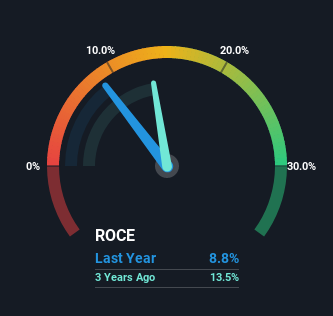- United States
- /
- Electronic Equipment and Components
- /
- NasdaqGS:NATI
Slowing Rates Of Return At National Instruments (NASDAQ:NATI) Leave Little Room For Excitement
If we want to find a potential multi-bagger, often there are underlying trends that can provide clues. One common approach is to try and find a company with returns on capital employed (ROCE) that are increasing, in conjunction with a growing amount of capital employed. Basically this means that a company has profitable initiatives that it can continue to reinvest in, which is a trait of a compounding machine. However, after investigating National Instruments (NASDAQ:NATI), we don't think it's current trends fit the mold of a multi-bagger.
Return On Capital Employed (ROCE): What is it?
For those that aren't sure what ROCE is, it measures the amount of pre-tax profits a company can generate from the capital employed in its business. The formula for this calculation on National Instruments is:
Return on Capital Employed = Earnings Before Interest and Tax (EBIT) ÷ (Total Assets - Current Liabilities)
0.088 = US$146m ÷ (US$2.1b - US$445m) (Based on the trailing twelve months to December 2021).
So, National Instruments has an ROCE of 8.8%. In absolute terms, that's a low return but it's around the Electronic industry average of 11%.
View our latest analysis for National Instruments

Above you can see how the current ROCE for National Instruments compares to its prior returns on capital, but there's only so much you can tell from the past. If you're interested, you can view the analysts predictions in our free report on analyst forecasts for the company.
The Trend Of ROCE
In terms of National Instruments' historical ROCE trend, it doesn't exactly demand attention. The company has consistently earned 8.8% for the last five years, and the capital employed within the business has risen 35% in that time. This poor ROCE doesn't inspire confidence right now, and with the increase in capital employed, it's evident that the business isn't deploying the funds into high return investments.
The Key Takeaway
In summary, National Instruments has simply been reinvesting capital and generating the same low rate of return as before. Although the market must be expecting these trends to improve because the stock has gained 44% over the last five years. Ultimately, if the underlying trends persist, we wouldn't hold our breath on it being a multi-bagger going forward.
One final note, you should learn about the 4 warning signs we've spotted with National Instruments (including 1 which doesn't sit too well with us) .
While National Instruments isn't earning the highest return, check out this free list of companies that are earning high returns on equity with solid balance sheets.
Valuation is complex, but we're here to simplify it.
Discover if National Instruments might be undervalued or overvalued with our detailed analysis, featuring fair value estimates, potential risks, dividends, insider trades, and its financial condition.
Access Free AnalysisHave feedback on this article? Concerned about the content? Get in touch with us directly. Alternatively, email editorial-team (at) simplywallst.com.
This article by Simply Wall St is general in nature. We provide commentary based on historical data and analyst forecasts only using an unbiased methodology and our articles are not intended to be financial advice. It does not constitute a recommendation to buy or sell any stock, and does not take account of your objectives, or your financial situation. We aim to bring you long-term focused analysis driven by fundamental data. Note that our analysis may not factor in the latest price-sensitive company announcements or qualitative material. Simply Wall St has no position in any stocks mentioned.
About NasdaqGS:NATI
National Instruments
National Instruments Corporation provides a software-centric platform to engineers and scientists worldwide.
Excellent balance sheet with proven track record and pays a dividend.
Market Insights
Community Narratives





